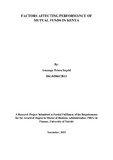| dc.description.abstract | The mutual Fund industry in Kenya has developed rapidly over the past two decades.
This can be attributed to the various advantages associated with mutual funds as opposed to
other investment instruments. Survival if the fund is purely determined by its performance in
the market. This is determined by growth of fund investments and amount of periodic returns
to investors for growth and value funds respectively. Furthermore, the growth in the mutual
funds market in Kenya has led to great interest in the risk – return relationship in the market.
Various asset pricing models can be utilized in empirical testing to determine the dominant
risk factors affecting funds in the market.
Kenyan fund market is still budding and of late it has not been performing well when
compared to other developed fund markets in the world. Despite this, little research has been
done to determine the reasons for poor performance and especially in studying the
fundamentals that determine the fund performance. They included risk and return, size,
investment styles, fund characteristics, behavioural patterns of investors, managerial
capabilities and persistence of returns. The study also adopted the arbitrage pricing model to
identify these factors. The Treasury bill, GDP growth rate, inflation size and the fund size
were the independent variables selected for the model whose beta parameters were analysed.
The research results will be of utmost importance to the fund managers, investors,
government and the academic fraternity. The study involved the registered fund managers in
Kenya, which stands at 16, according to the Retirements Benefit Authority (RBA). The
research design was descriptive and the researcher employed the census method of study
where each registered fund manager was issued with two questionnaires; one to the
investment manager and the other to the fund administrator. 28 out of 32 questionnaires
issued were duly completed and returned. The data collected was first subjected to descriptive
statistics including frequencies, percentages, means and standard deviations.
The study found that a positive relationship existed between mutual funds’ returns and
the Treasury bill rate and the market interest rates. A negative beta was computed for GDP
growth rate, inflation rate and fund size factors. These factors represent risk in the mutual
funds market and a positive risk return relationship as computed from the model. Inflation
rate, market interest rates and GDP growth rate were observed to have the greatest impact on
mutual fund returns. The fund size had a lower but significant coefficient while the beta for
Treasury bill rate factor was insignificant. It was also found that there is a negative
relationship between fund performance and behavioural patterns of investors.
The study recommends that Kenyan fund managers be exposed to the best investment
practices including adopting the appropriate styles and changing them frequently, holding the
right size of fund, cleverly selecting the funds to invest in, methods of assessing fund
performance among other investment style characteristics. | en_US |

